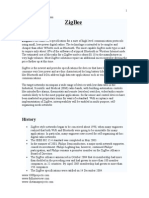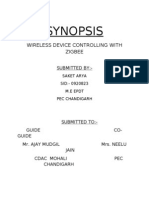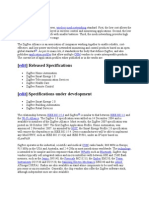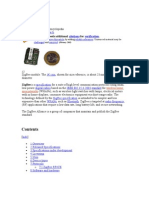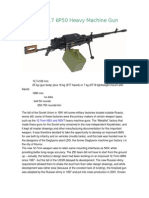Zigbee Protocol: A Seminar Report On
Zigbee Protocol: A Seminar Report On
Uploaded by
Kranthi ReddyCopyright:
Available Formats
Zigbee Protocol: A Seminar Report On
Zigbee Protocol: A Seminar Report On
Uploaded by
Kranthi ReddyOriginal Title
Copyright
Available Formats
Share this document
Did you find this document useful?
Is this content inappropriate?
Copyright:
Available Formats
Zigbee Protocol: A Seminar Report On
Zigbee Protocol: A Seminar Report On
Uploaded by
Kranthi ReddyCopyright:
Available Formats
ZIGBEE
A SEMINAR REPORT ON
ZigBee Protocol
SUBMITTED BY
Name University Exam No.
:Y.Sabitha : 08AG1A0563
UNDER GUIDANCE OF
Prof. Prem Kumar Sir
COMPUTER ENGINEERING DEPARTMENT, ACE Engineering College. * 2008-2012 *
ZIGBEE
DEPARTMENT OF COMPUTER ENGINEERING
CERTIFICATE
This is to certify that Y. Sabitha, Roll No. 08AG1A0563 has successfully completed seminar on
ZigBee Protocol
To my satisfaction and submitted the same during the academic year 2008-2012 towards the partial fulfillment of degree of Bachelor of Engineering under Pune University, under the Department of Computer Engineering , MIT College of Engineering, Pune.
Prof. Prem Kumar Bharathi
Prof. K.Jaya
Seminar Guide Department)
HOD (Computer
ZIGBEE
ACKNOWLEDGEMENT It gives me immense pleasure in presenting seminar on the topic Zigbee protocol. I acknowledge the enormous assistance and excellent co-operation extended to by my respected guide Prof. Prem Kumar. I would also like to thank the staff members for their valuable support. Lastly I would like to express my heartfelt indebtedness towards all those who have helped me directly or indirectly for the success of the seminar.
Y.Sabitha (Roll No. 08AG1A0563)
ZIGBEE
Table of Contents
1. Introduction1-2 2. Wireless Communication3-7 3.Why is Zigbee needed?.................................................................................................7-9 4.Zigbee Architecture..9-10 5. Specifications..10-18 6.How Zigbee works?.......................................................................................................18-19 7. Software and Hardware20 8. Latest News..21 9.Advantages of Zigbee over Proprietary Solutions 21 10. Uses.21-23 11. Conclusion..24
ZIGBEE
12. Bibliography24
Abstract
The concept of Zigbee is associated with controlling all electronic deceives and communicating with them self in the surrounding by using simple our mobile or P.c. by using this latest wireless technology. The serious problem in this world cables with tremendous growth in science this can with this. Zigbee act as sensor and controller Zigbee is operated at 2.4 GHz (ISM) bandwidth and IEEE standard is 802.15.4.This operated at low end frequency (HOME RF). It has data rate of 250 Kbps .This act as co-ordinate and slave. This gives commands and receives commands from other electronic deceives. This technology forms PAN topologies. This can connect up to 65,553 deceives per unit. It operated in 16 channels each channel take 868 Mbps. This is operated with in distance 75 to 100 Mts .The important feature of Zigbee is providing with memory and logical unit for first time. This helps in taking independent decisions by itself with need of co-ordinator, which help in sensor deceives. There are technologies, which already available in the market like Blue tooth. Theyre some ensured suides in that which lead to develop Zigbee. It has major advantage that it has low power consumption (30 milli Amps). In blue tooth reacting time 3 seconds but in Zigbee it will take only 3 Milli seconds. Other advantage is that it provides high security to all electronic deceives. Another imported thing is that it of low cost. This can all purpose in industries and home appliances. It is very simple to operate by ever one. By all my statements I can conclude that in future we are going to new world with cables, ever thing is done by single controls with out using muti switches muti purposes. All electronic deceives are provided with high security. Every thing is going to automatically this future project of Zigbee alliences.By supporting all the above statements I can say that ZIGBEE IS TO BIG B.
ZIGBEE
1.INTRODUCTION:
Now a days every electronic deceive is provided with sensor controller .It is every difficult to provide charged batteries to controllers and also to maintain them. At same time it must provide with logical thinking to protect deceive from wizards Imagine your home appliances communicating with each other or you controlling them using your cell phone or PC. Youre able to monitor and control the ambient temperature, moisture and Noises in the individual rooms, find out which room your kids are in or unlock the entry door to let your friend in from a remote location.
In the not-too-distant future, all this will be possible with ZigBee, which is expected to become a Big B.It would be common to find as many as a hundred of ZigBee chips around the house in the form of light switches, fire and smoke detectors, thermostats, kitchen appliances, video and audio remote controls, security systems, etc.
This manual provides an introduction to the various components of a ZigBee network. After a quick overview of ZigBee, we start with a description of high-level concepts used in wireless communication and move on to the specific protocols needed to implement the communication standards. This is
ZIGBEE
followed by a description of using a Rabbit-based board and Dynamic C libraries to form a ZigBee network.
ZigBee, a specification for communication in a wireless personal area network (WPAN), has been called the Internet of things. Theoretically, your ZigBee-enabled coffee maker can communicate with your ZigBee-enabled toaster. The benefits of this technology go far beyond the novelty of kitchen appliances coordinating your breakfast. ZigBee applications include: Home and office automation Industrial automation Medical monitoring Low-power sensors HVAC control Plus many other control and monitoring uses ZigBee targets the application domain of low power, low duty cycle and low data rate requirement devices. Figure 1.1 shows a block diagram of a ZigBee network with five
nodes.
ZIGBEE
Figure 1.1ZigBee Network
2. Wireless communication:
2.1Communication Systems All wireless communication systems have the following components Transmitter Receiver
ZIGBEE
Antennas Path between the transmitter and the receiver In short, the transmitter feeds a signal of encoded data modulated into RF waves into the antenna. The Antenna radiates the signal through the air where it is picked up by the antenna of the receiver. The receiver demodulates the RF waves back into the encoded data stream sent by the transmitter. 2.2 Wireless Network Types There are a number of different types of networks used in wireless communication. Network types are typically defined by size and location. 2.2.1 WPAN A wireless personal area network (WPAN) is meant to span a small area such as a private home or an individual workspace. It is used to communicate over a relatively short distance. The specification does not preclude longer ranges being achieved with the trade-off of a lower data rate. In contrast to other network types, there is little to no need for infrastructure with a WPAN. Ad-hoc networking is one of the key concepts in WPANs. This allows devices to be part of the network temporarily; they can join and leave at will. This works well for mobile devices like PDAs, laptops and phones. Some of the protocols employing WPAN include Bluetooth, ZigBee, Ultra-wideband (UWB) and IrDA. Each of these is optimized for particular applications or domains. ZigBee, with its sleepy, battery-powered end devices, is a perfect fit for wireless sensors. Typical ZigBee
ZIGBEE
application domains include: agricultural, building and industrial automation, home control, medical monitoring, security and, lest we take ourselves too seriously, toys, toys and more toys. 2.2.2 WLAN Wireless local area networks (WLANs) are meant to span a relatively small area, e.g., a house, a building, or a college campus. WLANs are becoming more prevalent as costs come down and standards improve. A WLAN can be an extension of a wired local area network (LAN), its access point connected to a LAN technology such as Ethernet. A popular protocol for WLAN is 802.11, also known as Wi-Fi.
2.2.3 WWAN A wireless wide area network (WAN) is meant to span a large area, such as a city, state or country. It makes use of telephone lines and satellite dishes as well as radio waves to transfer data.
2.3 Wireless Network Topologies
This section discusses the network topologies supported by the IEEE 802.15.4 and ZigBee specifications. The topology of a network describes how the nodes are connected, either physically or logically. The physical topology is a geometrical shape resulting from the physical links from node to node, as shown in Figure 2.1. The logical topology maps the flow of data between the nodes.
Figure 2.1 Physical Network Topologies Supported by ZigBee
10
ZIGBEE
The ZigBee specification supports star and two kinds of peer-to-peer topologies, mesh and cluster tree. ZigBee-compliant devices are sometimes specified as supporting point-to-point and point-tomultipoint.
11
ZIGBEE
2.4 Wireless Standards
The demand for wireless solutions continues to grow and with it new standards have come forward and other existing standards have strengthened their position in the marketplace. This section compares three popular wireless standards being used today and lists some of the design considerations that differentiate them. Wireless parameter Frequency band
Physical/MAC layers Current consumption Raw data rate Protocol stack size 1 Mbps 250 KB
Wi-fi 2.4GHz
IEEE 802.15.1 60 mA (Tx mode)
bluetooth 2.4GHz
IEEE 802.11b 400 mA (Tx mode) 20 mA (Standby mode) 11 Mbps 1 MB
zigbee 2.4GHz
IEEE 802.15.4 25-35 mA (Tx mode) 3 A (Standby mode) 250 Kbps 32 KB 4 KB (for limited function end devices) 64 K
Maximum number of nodes per network Number of channels
32 per access point
19
13
16
Each wireless standard addresses the needs of a different market segment. Choosing the best-fit wireless standard is a crucial step in the successful deployment of any wireless application. The requirements of your application will determine the wireless standard to choose.
2.5 Security in a Wireless Network
12
ZIGBEE
This section discusses the added security issues introduced by wireless networks. The salient fact that signals are traveling through the air means that the communication is less secure than if they were traveling through wires. Someone seeking access to your network need not overcome the obstacle of tapping into physical wires. Anyone in range of the transmission can potentially listen on the channel. Wireless or not, a network needs a security plan. The first thing to do is to decide what level of security is appropriate for the applications running on your network. For instance, a financial institution, such as a bank or credit union offering online account access would have substantially different security concerns than would a business owner offering free Internet access at a coffee shop. 2.5.1 Security Risks After you have decided the level of security you need for your network, assess the potential security risks that exist. Who is in range of the wireless transmissions? Can unauthorized users join the network? What would an unauthorized user be able to do if they did join? Is sensitive data traveling over the wireless channel? Network security is analogous to home security: You do not want your house to be a target so you do things to minimize your risk, whether that be outside lighting, motion sensors, or even just keeping bushes pruned back close to the house so bad guys have fewer hiding places. Deterrence is the goal because nothing is guaranteed to be 100% safe in the real world.
3. WHY IS ZIGBEE NEEDED
There are a multitude of standards like Blue tooth and WiFi that address mid to high data rates for voice, PC LANs, video, etc. However, up till now there hasn't been a wireless network
13
ZIGBEE
standard that meets the unique needs of sensors and control devices. Sensors and controls don't need high bandwidth but they do need low latency and very low energy consumption for long battery lives and for large device arrays. There are a multitude of proprietary wireless systems manufactured today to solve a multitude of problems that don't require high data rates but do require low cost and very low current drain. These proprietary systems were designed because there were no standards that met their application requirements. These legacy systems are creating significant interoperability problems with each other and with newer technologies. The ZigBee Alliance is not pushing a technology; rather it is providing a standardized base set of solutions for sensor and control systems. Comparision of zigbee with other technologies:
Standard Wi-Fi
Bandwidth
Power Protocol Consumpti Stack Size on UpW to 400+mA 100+KB 54Mbps TX, standby 20mA
Stronghold High rate
Applicatio ns
data Internet browsing, PC n/wing,file
14
ZIGBEE
transfers Bluetooth 1Mbps 40mA TX, ~100+KB standby 0.2mA 30mA TX, 4"32KB standby 3#&956; A Interoperabi Wireless lity, cable USB, replacement handset, headset Long battery life, low cost Remote control, batteryoperated products, sensors
ZigBee
250kbps
Comparison table
4.ZIGBEE ARCHITECTURE:
4.1Physical layer The physical layer was designed to accommodate the need for a low cost yet allowing for high levels of integration. The use of direct sequence allows the analog circuitry to be very simple and very tolerant towards inexpensive implementations. 4.2MAC layer The media access control (MAC) layer was designed to allow multiple topologies without complexity. The power management operation doesn't require multiple modes of operation. The MAC allows a reduced functionality device (RFD) that needn't have flash nor large amounts of ROM or RAM. The MAC was designed to handle large numbers of devices without requiring them to be "parked". The network layer has been designed to allow the network to spatially grow without requiring high power transmitters. The network layer also can handle large amounts of nodes with relatively low latencies . 4.3.Security Security and data integrity are key benefits of the ZigBee technology. ZigBee leverages the security model of the IEEE 802.15.4 MAC sub layer which specifies four security services: Access controlthe device maintains a list of trusted devices within the network
15
ZIGBEE
Data encryption, which uses symmetric key 128-bit advanced encryption standard Frame integrity to protect data from being modified by parties without cryptographic keys Sequential freshness to reject data frames that have been replayedthe network controller compares the freshness value with the last known value from the device and rejects it if the freshness value has not been updated to a new value The actual security implementation is specified by the implementer using a standardized toolbox of ZigBee security software
Zigbee architecture
5. Specifications:
This chapter gives an overview of the ZigBee specification. ZigBee, its specification and promotion, is a product of the ZigBee Alliance. The Alliance is an association of companies working together to ensure the success of this open global standard.
16
ZIGBEE
ZigBee is built on top of the IEEE 802.15.4 standard. ZigBee provides routing and multi-hop functions to the packet-based radio protocol.
5.1 Logical Device Types The ZigBee stack resides on a ZigBee logical device. There are three logical device types: coordinator router end device It is at the network layer that the differences in functionality among the devices are determined. See Table 4-1 for more information. It is expected that in a ZigBee network the coordinator and the routers will be mains-powered and that the end devices can be batterypowered.
In a ZigBee network there is one and only one coordinator per network. The number of routers and/or end devices depends on the application requirements and the conditions of the physical site.
17
ZIGBEE
Within networks that support sleeping end devices, the coordinator or one of the routers must be designated as a Primary Discovery Cache Device. These cache devices provide server services to upload and store discovery information, as well as respond to discovery requests, on behalf of the sleeping end devices.
5.2 ZigBee Stack Layers As shown in Figure 4.1, the stack layers defined by the ZigBee specification are the network and application framework layers. The ZigBee stack is loosely based on the OSI 7-layer model. It implements only the functionality that is required in the intended markets. 5.2.1 Network (NWK) Layer The network layer ensures the proper operation of the underlying MAC layer and provides an interface to the application layer. The network layer supports star, tree and mesh topologies. Among other things, this is the layer where networks are started, joined, left and discovered.
ZigBee Network Layer Function Coordinator Router End Device
Establish a ZigBee network. Permit other devices to join or leave the network Discover and record list of onehop neighbors Route network packets Receive or send
. . . . . . .
18
ZIGBEE
network packets Join or leave the network
. .
. .
. . .
Enter sleep mode
When a coordinator attempts to establish a ZigBee network, it does an energy scan to find the best RF channel for its new network. When a channel has been chosen, the coordinator assigns the logical network identifier, also known as the PAN ID, which will be applied to all devices that join the network. A node can join the network either directly or through association. To join directly, the system designer must somehow add a nodes extended address into the neighbor table of a device. The direct joining device will issue an orphan scan, and the node with the matching extended address (in its neighbor table) will respond, allowing the device to join. To join by association, a node sends out a beacon request on a channel, repeating the beacon request another channels until it finds an acceptable network to join. The network layer provides security for the network, ensuring both authenticity and confidentiality of a transmission. 5.2.2 Application (APL) Layer The APL layer is made up of several sublayers. The components of the APL layer are shown in Figure 4.2. and discussed below. The ovals symbolize the interface, called service access points (SAP), between different sublayer entities.
19
ZIGBEE
Figure 5.2 ZigBee-Defined Part of Stack
5.2.2.1 Application Support Sublayer (APS) The APS sublayer is responsible for: binding tables message forwarding between bound devices group address definition and management address mapping from 64-bit extended addresses to 16-bit NWK addresses fragmentation and reassembly of packets reliable data transport
20
ZIGBEE
The key to interfacing devices at the need/service level is the concept of binding. Binding tables are kept by the coordinator and all routers in the network. The binding table maps a source address and source endpoint to one or more destination addresses and endpoints. The cluster ID for a bound set of devices will be the same. As an example, consider the common control problem of maintaining a certain temperature range
5.2.2.3 ZigBee Device Object (ZDO) The ZDO is responsible for overall device management, specifically it is responsible for: initializing the APS sublayer and the NWK layer defining the operating mode of the device (i.e., coordinator, router, or end device) device discovery and determination of which application services the device provides initiating and/or responding to binding requests security management Device discovery can be initiated by any ZigBee device. In response to a device discovery inquiry end devices send their own IEEE or NWK address (depending on the request). A coordinator or router will send their own IEEE or NWK address plus all of the NWK addresses of the devices associated with it. (A device is associated with a coordinator or router if it is a child node of the coordinator or router.) Device discovery allows for an ad-hoc network. It also allows for a self-healing network. Service discovery is a process of finding out what application services are available on each node. This information is then used in binding tables to associate a device offering a service with a device that needs a that system. 5.3 ZigBee Addressing Before joining a ZigBee network (i.e., a LR-WPAN), a device with an IEEE 802.15.4compliant radio has 64-bit address. This is a globally unique number made up of an
21
ZIGBEE
Organizationally Unique Identifier (OUI) plus 40 bits assigned by the manufacturer of the radio module. OUIs are obtained from IEEE to ensure global uniqueness. When the device joins a Zigbee network, it receives a 16-bit address called the NWK address. Either of these addresses, the 64-bit extended address or the NWK address, can be used within the PAN to communicate with a device. The coordinator of a ZigBee network always has a NWK address of 0.ZigBee provides a way to address the individual components on the device of a node through the use of endpoint addresses. During the process of service discovery the node makes available its endpoint numbers and the cluster IDs associated with the endpoint numbers. If a cluster ID has more than one attribute, the command is used to pass the attribute identifier. 5.3.1 ZigBee Messaging After a device has joined the ZigBee network, it can send commands to other devices on the same network. There are two ways to address a device within the ZigBee network: direct addressing and indirect addressing. Direct addressing requires the sending device to know three kinds of information regarding the receiving device: 1. Address 2. Endpoint Number 3. Cluster ID Indirect addressing requires that the above three types of information be committed to a binding table. The sending device only needs to know its own address, endpoint number and cluster ID. The binding table entry supplies the destination address(es) based on the information about the source address. The binding table can specify more than one destination address/endpoint for a given source address/endpoint combination. When an indirect transmission occurs, the entire binding table is searched for any entries where the source address/endpoint and cluster ID matches the values of the transmission. Once a matching entry is found, the packet is sent to the destination address/endpoint. This is repeated for each entry where the source endpoint/address and clusterID match the transmission values.
22
ZIGBEE
5.3.2 Broadcast Addressing There are two distinct levels of broadcast addresses used in a ZigBee network. One is a broadcast packet with a MAC layer destination address of 0xFFFF. Any transceiver that is awake will receive the packet. The packet is re-transmitted three times by each device, thus these types of broadcasts should only be used when necessary. The other broadcast address is the use of endpoint number 0xFF to send a message to all of the endpoints on the specified device.
5.3.3 Group Addressing An application can assign multiple devices and specific endpoints on those devices to a single group address. The source node would need to provide the cluster ID, profile ID and source endpoint. 5.4 ZigBee Application Profiles What is a ZigBee profile and why would you want one? Basically a profile is a messagehandling agreement between applications on different devices. A profile describes the logical components and their interfaces. Typically, no code is associated with a profile. The main reason for using a profile is to provide interoperability between different manufacturers. For example, with the use of the Home Lighting profile, a consumer could use a wireless switch from one manufacturer to control the lighting fixture from another manufacturer. There are three types of profiles: public (standard), private and published. Public profiles are managed by the ZigBee Alliance. Private profiles are defined by ZigBee vendors for restricted use. A private profile can become a published profile if the owner of the profile decides to publish it.
23
ZIGBEE
All profiles must have a unique profile identifier. You must contact the ZigBee Alliance if you have created a private profile in order to be allocated a unique profile identifier. A profile uses a common language for data exchange and a defined set of processing actions. An application profile will specify the following: set of devices required in the application area functional description for each device set of clusters to implement the functionality which clusters are required by which devices
All clusters and attributes are given unique identifiers. Interfaces are specified at the cluster level. There are input cluster identifiers and output cluster identifiers. At time of this writing, the following public profiles are available: Commercial building automation Home automation Industrial plant monitoring Wireless sensor applications Smart energy
6.HOW ZIGBEE WORKS?
ZigBee operates in 16 channels of 2.4GHz ISM band and provides a data rate of 250 Kbps. It has been designed for single channel 868 MHz, which provides 20 kbps in Europe. ZigBee device can function either as a node or a coordinator. A node is like a client or slave device that receives commands/data from a coordinator. A node cannot initiate connection with another node. The coordinator device is the master or the slave device that can control up to 255 active nodes. ZigBee devices can form PAN using star, cluster tree or mesh topology. Multi network coordinators can be linked together to form a large network to control up to 65536 devices. Advanced encryption standards
24
ZIGBEE
(AES) will enable highly secure networks and application. Profile will provide highly interoperable products and solutions.
ZigBee networks use three device types:
The network coordinator maintains overall network knowledge. It's the most sophisticated of the three types and requires the most memory and computing power. The full function device (FFD) supports all 802.15.4 functions and features specified by the standard. It can function as a network coordinator. Additional memory and computing power make it ideal for network router functions or it could be used in network-edge devices (where the network touches the real world). The reduced function device (RFD) carries limited (as specified by the standard) functionality to lower cost and complexity. It's generally found in network-edge devices.
ZigBee protocol is optimized for time critical applications and allows network connections within 30 milliseconds compared to 3seconds for Blue Tooth. ZigBee devices are designed for periodic data of applications of defined rate (example: sensors), intermittent data that is application defined or determined by external stimulus (example: Light switches) and lowlatency data of allocated time slots (example: Mice)
TREE DIAGRAM:
25
ZIGBEE
7. Software And Hardware:
The software is designed to be easy to develop on small, inexpensive microprocessors. The radio design used by ZigBee has been carefully optimized for low cost in large scale production. It has few analog stages and uses digital circuits wherever possible. Even though the radios themselves are inexpensive, the ZigBee Qualification Process involves a full validation of the requirements of the physical layer. This amount of concern about the Physical Layer has multiple benefits, since all radios derived from that semiconductor mask set would enjoy the same RF characteristics. On the other hand, an uncertified physical layer that malfunctions could cripple the battery lifespan of other devices on a ZigBee network. Where other protocols can mask poor sensitivity or other esoteric problems in a fade compensation response, ZigBee radios have very tight engineering constraints: they are both power and bandwidth constrained. Thus, radios are tested to the ISO 17025 standard with guidance given by
26
ZIGBEE
Clause 6 of the 802.15.4-2006 Standard. Most vendors plan to integrate the radio and microcontroller onto a single chip.
8. Latest News:
RF4CE (Radio Frequency for Consumer Electronics) Consortium agreed to work with the ZigBee Alliance to jointly deliver a standardized specification for radio frequency-based remote controls. ZigBee RF4CE is designed to be deployed in a wide range of remotely-controlled audio/visual consumer electronics products, such as TVs and set-top boxes. It promises many advantages over existing remote control solutions, including richer communication and increased reliability, enhanced features and flexibility, interoperability, and no line-of-sight barrier.
9.ADVANTAGES ZIGBEE OVER PROPRIETARY SOLUTIONS Product interoperability.
Vendor independence.
27
ZIGBEE
Increased product innovation as a result of industry standardization. A common platform is more cost effective than creating a new proprietary solution from scratch every time.
10. Uses:
ZigBee protocols are intended for use in embedded applications requiring low data rates and low power consumption. ZigBee's current focus is to define a general-purpose, inexpensive, selforganizing mesh network that can be used for industrial control, embedded sensing, medical data collection, smoke and intruder warning, building automation, home automation, etc. The resulting network will use very small amounts of power individual devices must have a battery life of at least two years to pass ZigBee certification. Typical application areas include 10.1 Home controlling with zigbee 10.1.1 Conservation Capture highly detailed electric, water and gas utility usage data Embed intelligence to optimize consumption of natural resources
10.1.2.Convenience Install, upgrade and network home control system without wires Configure and run multiple systems from a single remote control 10.1.3 Safety Easily install wireless sensors to monitor a wide variety of conditions Receive automatic notification upon detection of unusual events 10.2.Industrial controlling with zigbee. 10.2.1. Conservation Reduce energy costs through optimized manufacturing process Identify inefficient operation or poorly performing equipment
28
ZIGBEE
10.2.2.Efficiency Automate data acquisition from remote sensors to reduce user intervention Provide detailed data to improve preventive maintenance programs 10.2.3.Safety Automate data acquisition from remote sensors to reduce user intervention Provide detailed data to improve preventive maintenance programs
10.3.Building controlling with zigbee 10.3.1. Control Integrate and centralize management of lighting, heating, cooling and security Automate control of multiple systems to improve conservation, flexibility and security 10.3.2.Conservation Reduce energy expenses through optimized HVAC management. Allocate utility costs equitably based on actual consumption. 10.3.3. Flexibility Reconfigure lighting systems quickly to create adaptable workspaces. Extend and upgrade building infrastructure with minimal effort. 10.3.4 Safety Network and integrate data from multiple access control points. Deploy wireless monitoring networks to enhance perimeter protection.
10.4. Water sensor It is used in big water towers that helps to indicate us that tank is going to full and also take care to stop water motor . 10.5. fire sensor It used in big hotels to stop fire wizards in accidents and also it calls fire engine. 10.6.Health centers It says to doctor up to date information of the patient and also take care of him by changing condition of room.
29
ZIGBEE
11. Conclusion:.
Above given theory I can conclude that in future we are going to see a world with out cables. We can give protection to all electronic deceive. We can take care and can avoid fire wizards. This step helps science technology to step into far word that help us to protect electronic deceives. By supporting all above statements I can say zigbee is going to big b
30
ZIGBEE
12. Bibliography:
1. www.zigbee.org 2. en.wikipedia.org/wiki/ZigBee 3. http://www.ieee802.org/15 4. http:// bheile@ieee.org
31
You might also like
- Taili Zhuang Portfolio 2022Document25 pagesTaili Zhuang Portfolio 2022Taili ZhuangNo ratings yet
- Crane, Hart - The BridgeDocument73 pagesCrane, Hart - The Bridgecsy7aa100% (2)
- Ae Board Review1 (Soil and Water)Document62 pagesAe Board Review1 (Soil and Water)yeng botz0% (1)
- DSR 2016 (Vol.2) PDFDocument258 pagesDSR 2016 (Vol.2) PDFJoe87% (38)
- Zigbee Characteristics and Benefits: What Is Zigbee TechnologyDocument3 pagesZigbee Characteristics and Benefits: What Is Zigbee TechnologySwetha SridellaNo ratings yet
- ZigBee NewDocument15 pagesZigBee Newlakshmi anusha achantaNo ratings yet
- Zigbee: Presented byDocument9 pagesZigbee: Presented bySwathi YennamNo ratings yet
- Seminar On-Seminar OnDocument41 pagesSeminar On-Seminar OnAnshula GuptaNo ratings yet
- IOT Notes Unit-3 Part-BDocument22 pagesIOT Notes Unit-3 Part-BECE N.V.Satyanarayana MurthyNo ratings yet
- Zigbee IntroductionDocument39 pagesZigbee IntroductionLakshmi VelkumarNo ratings yet
- Zigbee: Origin of WordDocument9 pagesZigbee: Origin of WordRajan VermaNo ratings yet
- Zigbee Technology Seminar PresentationDocument10 pagesZigbee Technology Seminar PresentationmithNo ratings yet
- Zigbee Wireless Control That Simply WorksDocument11 pagesZigbee Wireless Control That Simply WorksTb ShilpaNo ratings yet
- Synopsis: Wireless Device Controlling With ZigbeeDocument6 pagesSynopsis: Wireless Device Controlling With ZigbeeJaiparkash SaveliaNo ratings yet
- Gas Management & Disaster System Using ZigBeeDocument6 pagesGas Management & Disaster System Using ZigBeesalmanrashid79No ratings yet
- Magzin PDFDocument27 pagesMagzin PDFssdco226008No ratings yet
- Title: Zigbee Technology: Branch: Computer Class: TE Div: ADocument4 pagesTitle: Zigbee Technology: Branch: Computer Class: TE Div: AShivbabu JayswalNo ratings yet
- Seminar Report: Submitted To: Submitted byDocument17 pagesSeminar Report: Submitted To: Submitted byRohan VirmaniNo ratings yet
- Zig BeeDocument27 pagesZig BeeRicha SharmaNo ratings yet
- Seminar ReportDocument21 pagesSeminar ReportKunjesh MehtaNo ratings yet
- Application of Zigbee Technology in Telecommunication SystemDocument7 pagesApplication of Zigbee Technology in Telecommunication SystemPraveen D JadhavNo ratings yet
- Zigbee Reminder System For Mobile Data Transfer in AirportDocument69 pagesZigbee Reminder System For Mobile Data Transfer in Airportदेवेश सिंह राजपूतNo ratings yet
- Users Make A Beeline For Zigbee Sensor Technology: Industry TrendsDocument4 pagesUsers Make A Beeline For Zigbee Sensor Technology: Industry TrendsdabrevipulNo ratings yet
- Zigbee FJFJK FJKDocument33 pagesZigbee FJFJK FJKrayedkhanNo ratings yet
- Zigbee Technology FinalDocument14 pagesZigbee Technology Finalduduck1000No ratings yet
- Zig BeeDocument26 pagesZig BeeSunil SharmaNo ratings yet
- 1 Coin: Zigbee Is ADocument17 pages1 Coin: Zigbee Is AShrikant JagtapNo ratings yet
- ZigbeeDocument6 pagesZigbeeRavikumar GoliNo ratings yet
- Seminar ReportDocument22 pagesSeminar ReportArchana BrahmaNo ratings yet
- Zigbee: From Wikipedia, The Free EncyclopediaDocument7 pagesZigbee: From Wikipedia, The Free EncyclopediaShruti VazeNo ratings yet
- Zigbee TechnologyDocument25 pagesZigbee TechnologyClassic PrintersNo ratings yet
- Introduction:-: ZigbeeDocument4 pagesIntroduction:-: ZigbeemaheshrylNo ratings yet
- Seminar Report On ZigbeeDocument17 pagesSeminar Report On ZigbeeMansoor ChowdhuryNo ratings yet
- XbeeeDocument4 pagesXbeeeHarish PandamaneniNo ratings yet
- Zigbee: Guide By: Anurada Khade MamDocument11 pagesZigbee: Guide By: Anurada Khade MamRahul MashereNo ratings yet
- Zigbee TechnologyDocument20 pagesZigbee TechnologyJagan VNo ratings yet
- Zigbee: Zigbee Is An Ieee 802.15.4-Based Specification For A Suite of High-Level CommunicationDocument6 pagesZigbee: Zigbee Is An Ieee 802.15.4-Based Specification For A Suite of High-Level CommunicationsweetsureshNo ratings yet
- Zigbee Technology: Wireless Control Made SimpleDocument25 pagesZigbee Technology: Wireless Control Made SimpleSaideepakNo ratings yet
- Zigbee Thesis ProjectDocument6 pagesZigbee Thesis Projectgcq5c1pv100% (2)
- Technical Overview: Wireless Mesh NetworkDocument13 pagesTechnical Overview: Wireless Mesh NetworkNaveen Telugudesam0% (1)
- Zigbee TechnologyDocument19 pagesZigbee TechnologychaitanyaponnamaneniNo ratings yet
- Presented To: Presented By:: Mr. Hemant Ukey LECT. (E.C.E.) Mraduraje Sisodiya & Nishi JoshiDocument15 pagesPresented To: Presented By:: Mr. Hemant Ukey LECT. (E.C.E.) Mraduraje Sisodiya & Nishi JoshiMradu SisodiyaNo ratings yet
- ZigbeeDocument2 pagesZigbeeneethuchNo ratings yet
- Computer Hardware 1Document4 pagesComputer Hardware 1arunimaanilkumar0No ratings yet
- M.tech Project PaperDocument10 pagesM.tech Project PaperRakshithaNo ratings yet
- ZigbeeDocument9 pagesZigbeelikithavonamalaNo ratings yet
- New Seminar On ZigbeeDocument24 pagesNew Seminar On ZigbeeMansoor ChowdhuryNo ratings yet
- Zigbee TechnologyDocument20 pagesZigbee TechnologyChikkapriyankaNo ratings yet
- Technical Overview: Zigbee Is ADocument12 pagesTechnical Overview: Zigbee Is AyouaredeadNo ratings yet
- Design and Implementation of A Zigbee-Based Wireless Automatic Meter Reading SystemDocument5 pagesDesign and Implementation of A Zigbee-Based Wireless Automatic Meter Reading SystemPatricio Rojas CarrascoNo ratings yet
- Switch On IoT Connected Lighting - Element14Document6 pagesSwitch On IoT Connected Lighting - Element14Sree SagarNo ratings yet
- Zigbee - An Emerging Technology For FutureDocument4 pagesZigbee - An Emerging Technology For FutureLuis Filipe SilvaNo ratings yet
- How Does ZigBee Compare With Other Wireless StandardsDocument6 pagesHow Does ZigBee Compare With Other Wireless StandardsChirag MistryNo ratings yet
- Wireless Automation Using Zigbee Technology: Presentation-IDocument14 pagesWireless Automation Using Zigbee Technology: Presentation-IVijay EmmanuelNo ratings yet
- Zigbee TechnologyDocument9 pagesZigbee TechnologyRonald Allan Matubang MadlaNo ratings yet
- Zigbee Home Automation ThesisDocument7 pagesZigbee Home Automation Thesisafcnzcrcf100% (2)
- Zigbee Vs BluetoorhDocument7 pagesZigbee Vs BluetoorhMehulLathiyaNo ratings yet
- Zigbee - WikipediaDocument64 pagesZigbee - WikipediaAfsar kamalNo ratings yet
- Zigbee Technology IJERTCONV3IS10001Document4 pagesZigbee Technology IJERTCONV3IS10001bhuvaneshv274No ratings yet
- Zigbee-A New Generation Technology: For Why I Am Choosing This TopicDocument6 pagesZigbee-A New Generation Technology: For Why I Am Choosing This TopicSellam PannerNo ratings yet
- The 5G Revolution: How the Next Generation of Wireless Will Change EverythingFrom EverandThe 5G Revolution: How the Next Generation of Wireless Will Change EverythingNo ratings yet
- Building the Internet of Things with IPv6 and MIPv6: The Evolving World of M2M CommunicationsFrom EverandBuilding the Internet of Things with IPv6 and MIPv6: The Evolving World of M2M CommunicationsNo ratings yet
- November 2023 Online - Loyalty Management MagazineDocument25 pagesNovember 2023 Online - Loyalty Management MagazineLoyalty360No ratings yet
- Final Oral ExamenDocument2 pagesFinal Oral ExamenYUNIORNo ratings yet
- Complete Idiot's Guide To Living With Breast CancerDocument401 pagesComplete Idiot's Guide To Living With Breast CancerVirendra JoshiNo ratings yet
- Analisis Farmasi Dasar - 1 REVDocument126 pagesAnalisis Farmasi Dasar - 1 REVBadzlinaKhairunizzahra100% (1)
- Self-Reliance BookDocument20 pagesSelf-Reliance Bookহেল্পডেস্ক ইএলএল-আইআইইউসিNo ratings yet
- Kord 12 7 6P50 Heavy Machine GunDocument2 pagesKord 12 7 6P50 Heavy Machine Gunsaledin1100% (1)
- Exam - Math - 10 - 1st - PEDocument1 pageExam - Math - 10 - 1st - PELavander BlushNo ratings yet
- Pantalla Anterior Bienvenido: Cr080vbesDocument3 pagesPantalla Anterior Bienvenido: Cr080vbesJuan Pablo Virreyra TriguerosNo ratings yet
- Delhi Voter Inquiry DetailsDocument3 pagesDelhi Voter Inquiry DetailsKunal1328No ratings yet
- Chp4 Vocab Word HelpsDocument2 pagesChp4 Vocab Word HelpsRobert CNo ratings yet
- Admit CardDocument3 pagesAdmit CardSONU SNo ratings yet
- CSB 12-9 2Document2 pagesCSB 12-9 2omarpatNo ratings yet
- AAS Level 1 - B1U1 - Lesson PlanDocument16 pagesAAS Level 1 - B1U1 - Lesson PlanTuân DucNo ratings yet
- ELA10 (S) Death Customs Oral Presentation - Mia MDocument8 pagesELA10 (S) Death Customs Oral Presentation - Mia MMia EmillaNo ratings yet
- The Computer RevolutionDocument4 pagesThe Computer Revolutionoanh nguyenNo ratings yet
- The Effect of DomesDocument5 pagesThe Effect of DomesStart إبدأNo ratings yet
- Vehicle Loan Default PredictionDocument14 pagesVehicle Loan Default PredictionSankeeta JhaNo ratings yet
- Maths Winter ProjectDocument7 pagesMaths Winter ProjectYash JoshiNo ratings yet
- Edarabia ADEC Emirates Future International Academy 2015 2016 PDFDocument17 pagesEdarabia ADEC Emirates Future International Academy 2015 2016 PDFEdarabia.comNo ratings yet
- Practical File (Final)Document44 pagesPractical File (Final)sahana anuNo ratings yet
- Cozzani Et Al 2007Document12 pagesCozzani Et Al 2007vincio89No ratings yet
- Gauss Quadrature 2 Point and 3 Point Formula PDFDocument9 pagesGauss Quadrature 2 Point and 3 Point Formula PDFRavi ParkheNo ratings yet
- Grunwald LetnikovDocument10 pagesGrunwald LetnikovNassira MadaniNo ratings yet
- The Way of Illumination Vol 1Document207 pagesThe Way of Illumination Vol 1api-3702097No ratings yet
- Districts Training Schedule YUVADocument21 pagesDistricts Training Schedule YUVAsanamsudan8808No ratings yet
- When Things Don T Fall Apart Global Financial Governance and Developmental Finance in An Age of Productive Incoherence The MIT Press 1st Edition Grabel PDF Full ChapterDocument25 pagesWhen Things Don T Fall Apart Global Financial Governance and Developmental Finance in An Age of Productive Incoherence The MIT Press 1st Edition Grabel PDF Full Chaptergarfinaishaa100% (11)












